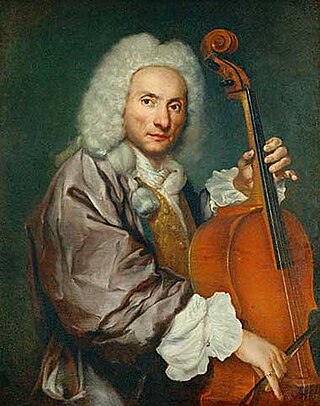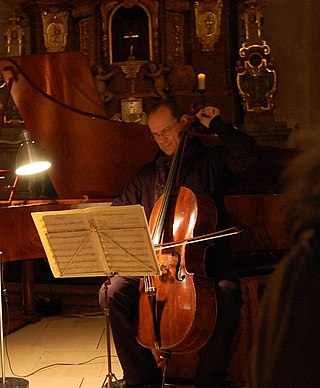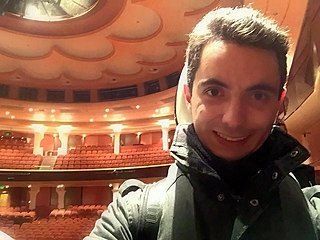Related Research Articles
The concerto grosso is a form of baroque music in which the musical material is passed between a small group of soloists and full orchestra. This is in contrast to the solo concerto which features a single solo instrument with the melody line, accompanied by the orchestra.
The trio sonata is a genre, typically consisting of several movements, with two melody instruments and basso continuo. It originated in the early 17th century and was a favorite chamber ensemble combination in the Baroque era.

Francesco Maria Veracini was an Italian composer and violinist, perhaps best known for his sets of violin sonatas. As a composer, according to Manfred Bukofzer, "His individual, if not subjective, style has no precedent in baroque music and clearly heralds the end of the entire era", while Luigi Torchi maintained that "he rescued the imperiled music of the eighteenth century", His contemporary, Charles Burney, held that "he had certainly a great share of whim and caprice, but he built his freaks on a good foundation, being an excellent contrapuntist". The asteroid 10875 Veracini was named after him.

Giovanni Battista Cirri was an Italian cellist and composer in the 18th century.

Antonio Vandini, a close friend of Giuseppe Tartini, was a cellist and composer. He was one of the foremost virtuoso performers of his era and spent the vast majority of his career as the first violoncellist of the ″Veneranda Arca″ at the Basilica del Santo in Padua, where Tartini was first violinist and concertmaster. Upon the death of Tartini, he returned to Bologna, the city of his birth, where he died in 1778.
Kristin (Gräfin) von der Goltz is a German-Norwegian cellist. She plays music from the baroque repertoire, but she also performs music from later periods. Her five older brothers include the violinist and conductor Gottfried von der Goltz.
Jan Šťastný was a Czech composer and cellist from the end of the 18th century to the beginning of the 19th century. He is considered one of the founders of Czech national violoncello school.

The Sonata in E major for flute and basso continuo is a sonata for transverse flute and figured bass composed by J. S. Bach in the 1740s. It was written as the result of a visit in 1741 to the court of Frederick the Great in Potsdam, where Bach's son Carl Philipp Emanuel had been appointed principal harpsichordist to the king the previous year. It was dedicated to Michael Gabriel Fredersdorf, the king's valet and private secretary, who, like the king, was an amateur flautist.
Giovanni Battista Vitali was an Italian composer and violone player.
Giovanni Benedetto Platti was born possibly 9 July 1697 in Padua, then belonging to Venice. He was an Italian Baroque composer and oboist. He died 11 January 1763 in Würzburg.

Johann Christian Schickhardt was a German composer and woodwind player.
Fitzwilliam Sonatas is the name first given by Thurston Dart to an arrangement he made, based on two recorder sonatas by George Frideric Handel, which he recast as a group of three sonatas. The term was applied by later editors to the original two sonatas as Handel wrote them, and was also expanded to encompass several other sonatas for various instruments included in the Handel autograph manuscripts held by the Fitzwilliam Museum in Cambridge.

Antonio Vivaldi composed several sonatas for cello and continuo. A set of six cello sonatas, written between 1720 and 1730, was published in Paris in 1740. He wrote at least four other cello sonatas, with two manuscripts kept in Naples, another in Wiesentheid, and one known to be lost.

Sergei Istomin is a cellist and a viola da gamba player. He began his violoncello studies at the age of six at the Gnessin School for gifted children in Moscow, Russia, where he obtained his bachelor's degree. He completed his master's degree at the Moscow Tchaikovsky Conservatory in the class of Valentin Feigin and then later his post-graduate studies with Catharina Meints Caldwell at the Oberlin Conservatory of Music and August Wenzinger at the Oberlin Baroque Performance Institute (BPI). In 2018 he received his Doctor of Arts (Music) degree at the Ghent University, Belgium. His doctoral thesis "Variations on a Rococo theme, Op.33: Pyotr Tchaikovsky and Karl Friedrich Wilhelm Fitzenhagen: a creative collaboration. Moscow and Saint Petersburg violoncello schools in the light of European traditions: a historical and textological clarification" is in the field of historically informed performance practice and musicology.
Giuseppe Maria Jacchini was an Italian cellist and composer.

Bruno Cocset is a baroque cello player. After studying in National Conservatory of Tours, he received classes from Anner Bylsma, Jaap Schröder and Christophe Coin. He has worked with many of the most important "historically informed" groups of Europe, having recording mainly with Jordi Savall's Le Concert des Nations before he created his own baroque ensemble: Les Basses Réunies. He is well known for the "rescue" of forgotten composers, such as Jean-Baptiste Barrière or Evaristo Felice Dall'Abaco, two examples of a vast corpus of recordings including innovative versions of Bach Cello Suites and Vivaldi Cello Concerti and Sonatas.

The Paris quartets is a collective designation for two sets of Chamber music compositions, each consisting of six works for flute, violin, viola da gamba, and continuo, by Georg Philipp Telemann, first published in 1730 and 1738, respectively. Telemann called his two collections Quadri and Nouveaux Quatuors. The collective designation "Paris quartets" was only first bestowed upon them in the second half of the twentieth century by the editors of the Telemann Musikalische Werke, because of their association with Telemann's celebrity visit to Paris in 1737–38. They bear the numbers 43:D1, 43:D3, 43:e1, 43:e4, 43:G1, 43:G4, 43:g1, 43:A1, 43:A3, 43:a2, 43:h1, 43:h2 in the TWV.
Julius Berger is a German cellist, musicologist and an academic of chamber music and cello at the Leopold Mozart Centre of the Augsburg University. He recorded the sonatas and concertos by Luigi Boccherini, but also contemporary music by John Cage, Toshio Hosokawa, Adriana Hölszky and Sofia Gubaidulina. He is the artistic director of music festivals.

Stéphane Tétreault is a Canadian cellist. He first made international headlines as the recipient of Bernard Greenhouse's cello, the 1707 "Countess of Stainlein Ex-Paganini" Stradivarius, generously loaned to him by Mrs. Jacqueline Desmarais and following her death by her daughter Mrs. Sophie Desmarais.

Claire Guimond is a Canadian flute player, founding member and former Artistic Director of Arion Baroque Orchestra.
References
- 1 2 3 4 5 6 7 8 9 10 11 "Elinor Frey". Passacaille. Retrieved May 31, 2024.
- 1 2 "Guided By Voices". Out-Here Music. Retrieved May 31, 2024.
- ↑ "Early Music America Fall 2012 - EMA Competition". www.nxtbook.com. Retrieved May 31, 2024.
- ↑ Zwartz, Barney (March 1, 2023). "How to get a rare instrument to tell you its story, and other fiddly questions". The Age. Retrieved May 31, 2024.
- ↑ "Elinor Frey". Music. Retrieved May 31, 2024.
- ↑ "Fiche". Faculté de musique - Université de Montréal (in French). Retrieved May 31, 2024.
- ↑ "Prix Opus, Lauréats An 1 à 23" (PDF). Prix Opus (in French). Retrieved May 31, 2024.
- ↑ "Lisez Diapason du 01 juillet 2020 sur ePresse.fr". epresse.fr (in French). July 1, 2020. Retrieved May 31, 2024.
- ↑ "Lauréats, 24eme édition/ Saison 2019-2020" (PDF). Prix Opus (in French). Retrieved May 31, 2024.
- ↑ "Elinor Frey". The JUNO Awards. Retrieved May 31, 2024.
- ↑ "Jean Baur: Chamber Music". 27e Gala des Prix Opus du Conseil québécois de la musique (in Canadian French). November 21, 2023. Retrieved May 31, 2024.
- 1 2 3 4 5 6 "Elinor Frey Songs, Albums, Reviews, Bio & More..." AllMusic. Retrieved May 31, 2024.
- ↑ "LEO, SAMMARTINI, TARTINI & VIVALDI: EARLY ITALIAN CELLO CONCERTOS". Out-Here Music. Retrieved May 31, 2024.
- ↑ "Pachelbel: Magnificat Fugues". Out-Here Music. Retrieved May 31, 2024.
- 1 2 3 4 5 6 7 8 9 10 11 "au="Frey, Elinor" - Search Results". search.worldcat.org. Retrieved May 31, 2024.